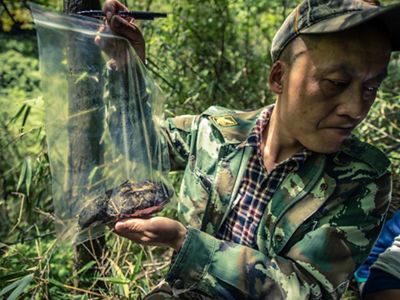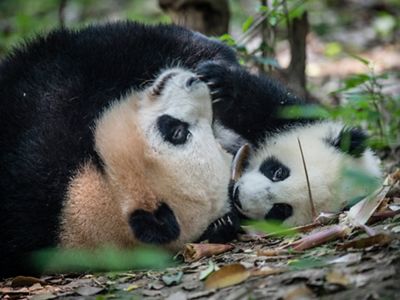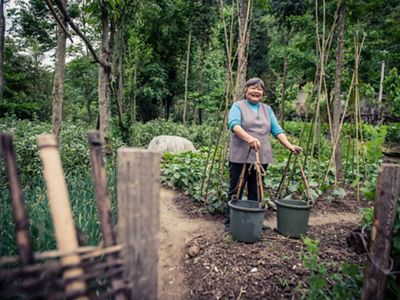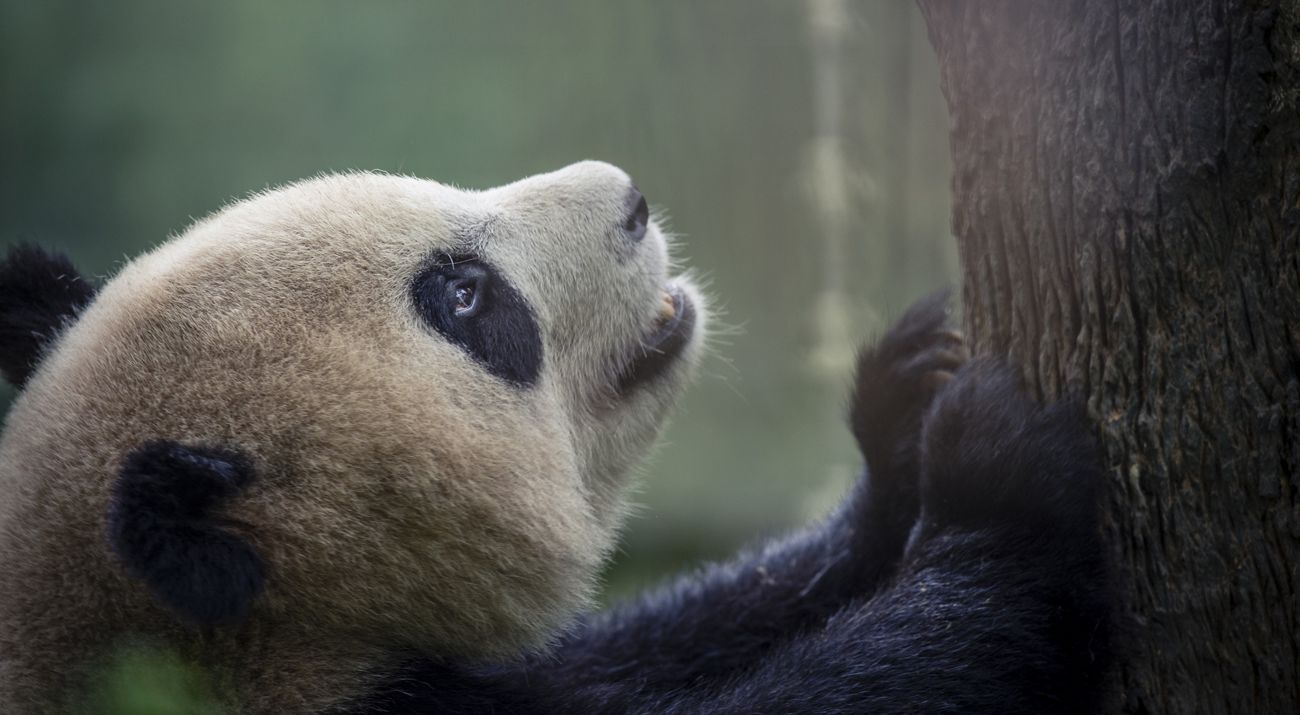Land of Giants
China’s first land trust is preserving panda habitat while breaking new ground in conservation.
December/January 2014
In a fantastically rugged spur of the Min Mountains, in northeastern Sichuan Province, Li Sheng and Zhang Youshun bushwhack through a dense thicket of bamboo. The towering, pine-clad precipices and yawning gorges here feel like a land out of a Chinese sword-fighter movie. The two men are among some two dozen researches combing The Nature Conservancy's 27,325-acre Laohegou Nature Reserve for signs of elusive giant pandas and other animals.
Li, a cherubic assistant professor of zoology and conservation biology from Peking University, and Zhang, a logger-turnedranger, have been assigned to a valley whose name, expansively interpreted, means Twisted Gulch. On the map, their survey line looks crisp and uncomplicated. In reality, it feels like a route scribbled by a madman.
As streams tumble past them to feed a rock-clogged tributary of the Yangtze far below, Li and Zhang climb out of willow, maple, rhododendron and pungent dang shen (“poor man’s ginseng”) into larch, fir and Chinese spruce. To climb higher, they have to grab ever-thicker clumps of bamboo and haul themselves, hand over hand, up the steep slope. This is full-contact science: Thrashing one’s way through the thick bamboo feels like getting caned on the shins.

Suddenly, Zhang—who resembles a grizzled Chinese version of George Clooney in sports canvas high-tops—yells, “I can’t see a way forward!”
“This isn’t easy work,” Li says as he catches his breath.
The men confer for several minutes, peering through the wall of bamboo ahead. Then Zhang unleashes a steel brush hook that resembles a medieval implement of war and slowly clears a path. He and Li inch higher and higher, up into a fresh-smelling realm of Chinese hemlock, Siberian fir and “dragon spruce.”
Some 2,600 vertical feet later, they clamber onto a rocky ridgeline that’s raked by a chilling wind. There, Li spots the holy grail, a burrito-sized wad of what look like chewed matchsticks: panda scat. He pries a binder from his backpack and takes a reading with his GPS unit. Then he and Zhang measure the scat, and Li jots a series of notes onto a survey form. He puts the specimen in a Ziploc bag and stuffs it into his pack to send off for analysis later.
The odds of actually seeing a panda here are tiny. Li has been studying them for more than a decade and has yet to see one in the wild. But researchers can use the DNA in the scat—and the size of the bite marks still visible on the bamboo within it—to identify individual animals that live in the reserve.
Although pandas are the celebrities here, a host of other animals call Laohegou home, too, including Sichuan golden monkeys, musk deer, takin, black bears, Asian golden cats and golden pheasants. Protecting this particular piece of northeastern Sichuan has filled a critical gap in a much larger mosaic of protected areas nearby, creating a large swath of uninterrupted habitat. But Laohegou—and the people behind the reserve—is also an important piece in an even bigger puzzle: the growing effort to prove out a new model of conservation in China that gives nongovernmental entities a role in helping to protect the country’s ecologically important places.

China is famous for being the world’s most populous country, but it’s also the fourth-largest country in terms of total land and water area. It spans a vast array of habitats, from the grasslands of the Tibetan plateau to wetlands near Shanghai. More than 2,500 nature reserves of various kinds have been officially protected throughout the country—the vast majority since the late 1990s, reflecting a rising tide of environmental concern here.
But many of China’s protected areas are what conservationists call paper parks: Although they exist on maps, they aren’t necessarily well funded or actively managed.
“In China, the government is the big player when it comes to conservation,” says Zhao Peng, the director of conservation for The Nature Conservancy in China. “But there’s still a real lack of money.”
For years, China’s strict landownership laws have made it difficult for nongovernmental organizations to play a significant role in land protection. But that’s beginning to change. Even as the government maintains ownership of all land in China, in 2008 it opened the door for Chinese private entities—including conservation groups—to hold forest-management rights.
That was good timing, since the Conservancy’s China program was already drafting a nationwide “conservation blueprint” to identify places in need of additional protection.
“This was the first time anyone really looked at all biodiversity issues from a national level and saw where the priority areas were,” says Ling Lin, the Conservancy’s Sichuan program director. The blueprint would ultimately be incorporated into the Chinese government’s National Biodiversity Conservation Strategy and Action Plan, which was released in 2010.
The blueprint helped focus conservationists’ attention on this remote part of Sichuan, Ling says. “It let people see that [Laohegou] is a really critical area not only in the province, but in the entire country.”

Scientists believe that more than 200 pandas live in Pingwu County—more than in any other county in China. The Conservancy realized that by protecting Laohegou, which had formerly been managed as a “forestry farm” by a logging company, it could create a continuous swath of habitat woven together with several existing governmentmanaged reserves in the area.
“We wanted to connect these areas with each other to make sure they have ecosystem integrity,” says Ling.
That’s a simple enough goal, but accomplishing it was a complicated process, since as a foreign entity The Nature Conservancy can’t legally hold land-management rights in China. As it happened, though, the Conservancy’s China program was already exploring an increasingly independent course from the organization’s Arlington, Virginia-based Worldwide Office.
The move was, in large part, a matter of financial necessity. “The Nature Conservancy was really impacted by the global economic downturn” in 2008, Zhao says, and as a result the China program had to lay off a third of its staff. “But,” he says, “the good thing is that we started to rethink our strategy in China.”
The China program began building its ability to get support within the country. It assembled a well-connected board that now includes several of the country’s most prominent executives, including Jack Ma, the founder of Internet commerce giant Alibaba, which recently made a
record-breaking debut on the New York Stock Exchange.
Still, only a purely Chinese entity could contract with the national government to acquire the land-use rights necessary to manage a nature preserve. So Shawn Zhang, the Conservancy’s China program director, worked to create a separate, wholly Chinese organization called the
Sichuan Nature Conservation Foundation.
Established in 2011, the foundation is the first private land trust in China. It, in turn, entered into a 50-year lease of management rights from the government for Laohegou.
“We want to show that a nongovernmental organization can play an important role in conservation here,” says Zhao. By bringing private money into the effort, he says, “we want to create a way to broaden the funding sources for protected areas. We’re shaping the future here.”

Perched on a ridge high over Twisted Gulch, Li Sheng and Zhang Youshun dig into their packs for lunch rations: canned porridge, a handful of pork-stuffed biscuits and a humongous cucumber. This is a landscape that defies human designs. For roughly 40 million years, the land here has been busy rearranging itself—most famously in 2008, when the great Sichuan earthquake struck. The temblor partially collapsed what is now the base camp at Laohegou and wiped out the sole road leading into the area. In the years since, a massive reconstruction effort throughout the region has created a host of concrete-heavy new towns, but up here, far from the clatter of track hoes and rock crushers, life still has a distinctly wild feeling.
Li Sheng has been working in the area for more than a decade. He’s used to the difficult terrain and points out that it has advantages from a conservation perspective. Although a logging company operated in Laohegou from 1972 to 1998, much of the area escaped the chainsaw’s cut. “Only 30 or 40 percent of it has been logged,” says Li. “A lot of it is just too steep.”
In the past three years, the Sichuan Nature Conservation Foundation has rebuilt the base camp and put the roughly two dozen former employees of the logging company onto its payroll as rangers and support staff. Both they and the foundation’s five staff members, plus visiting scientists like Li Sheng, have been working to build a baseline inventory of the wildlife here—an effort that also occasionally brings in rangers from neighboring government-run reserves.
Even as they’re trying to better understand what’s happening inside the reserve, the Conservancy and the foundation are also working to tie nearby villages into a sustainable economy so people won’t have to venture into the reserve to hunt, fish or gather resources. The foundation’s $16,000 community development fund is helping to jump-start a guesthouse and an agriculture program that connects farmers to high-end markets for sustainable food products. It has already generated $300,000 through catalog orders for things like honey, eggs, chickens, sausage and persimmons.
Chen Xiaohong lives in Minzhu village, just outside the reserve, with his wife and daughter. In the past, he says, he often had to travel to cities as much as 1,200 miles away in search of work as a temporary laborer. Now, though, he and a cousin are building a guesthouse with a loan from the community development fund. Opportunities like this could help stanch a flow of people leaving the village to seek outside jobs. “Everyone had to leave for the cities to make money,” he says. “But this gives us a chance to stay here, where we grew up.”

In its own way, Laohegou’s transition from logging operation to nature reserve mirrors the increasing focus on environmental protection throughout China. And Laohegou is just the beginning. Though important, it’s but one small part of a larger effort to expand privately protected lands nationwide.
Now, Zhao says, it’s time to scale up: “We’re thinking about how to replicate this model over the next three to five years to establish 10 sites managed by the Conservancy.”
Many of those sites will be in the Southwest, in Sichuan and Yunnan provinces, where the Conservancy already has a strong presence. But the organization is also exploring opportunities in Shanghai and Hangzhou, as well as eyeing Shenzhen and Inner Mongolia.
“We’re trying to identify the most critical conservation gaps,” says the Conservancy’s Ling. The Conservancy is also seeking partnerships with existing, government-run preserves. “We can work together and help them build the capacity to manage those sites more effectively.”
Earlier this year, the Conservancy signed preliminary agreements to cooperatively manage parts of Dongtan and Bayuelin nature reserves; it is preparing to sign a similar agreement for the Baishahe forest farm.
High on the ridge over Twisted Gulch, the air begins to chill, and a sudden boom rolls across the valleys. “Da lei le!”—thunder!—grunts Zhang Youshun.
He and Li gather their gear and stuff it into their packs. Over the remainder of the week, the survey teams will find more than 100 specimens of panda scat, including six samples fresh enough to suggest that pandas had left them within the previous few days. All of that is now being analyzed to determine the exact number of giant pandas in Laohegou and bring sharper focus to one of the world’s most beloved species. For now, though, the two men pick their way down past rocky pinnacles into the mist-shrouded valley below. •
